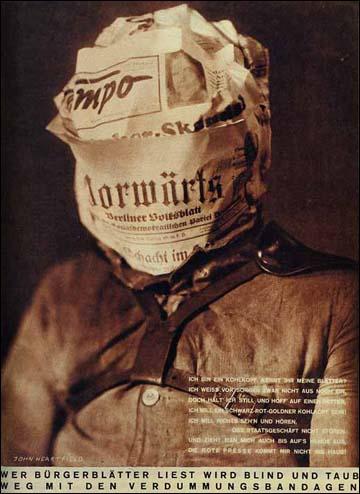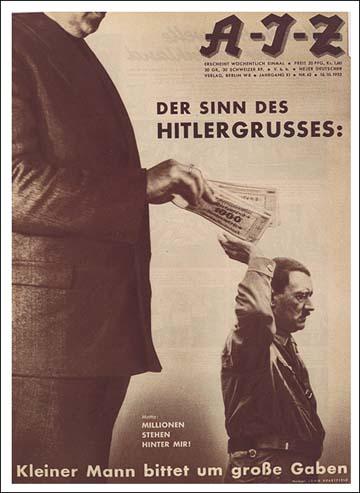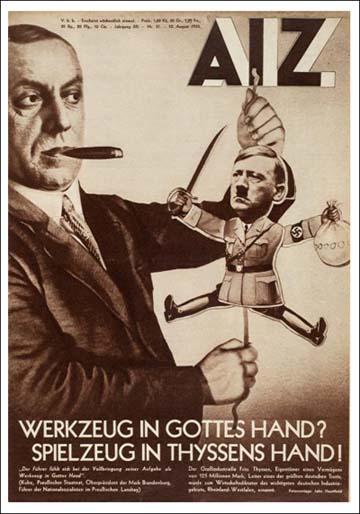Classroom Activity on Adolf Hitler v John Heartfield
All forms of mass communication were controlled in Nazi Germany. The man in overall charge was Dr.Joseph Goebbels, the Minister of Propaganda. Lists were drawn up of books the Nazis believed contained "un-German" ideas and then all available copies were publically destroyed. The Nazis were especially hostile to works produced by left-wing writers like Bertolt Brecht and Ernst Toller. The decision to censor works of art was not only motivated by the fear that alternative political ideas would be communicated; the Minister of Propaganda even banned the music of Jewish composers like Felix Mendelssohn and Gustav Mahler.
Primary Sources

(Source 2) Adolf Hitler, Mein Kampf (1925)
The chief function (of propaganda) is to convince the masses, whose slowness of understanding needs to be given time in order that they may absorb information; and only constant repetition will finally succeed in imprinting an idea on their mind ... The slogan must of course be illustrated in many ways and from several angles, but in the end one must always return to the assertion of the same formula. The one will be rewarded by the surprising and almost incredible results that such a persistent policy secures.
(Source 3) Adolf Hitler, proclamation (14th July, 1933)
The German Government has enacted the following law, which is herewith promulgated:
Article 1: The National Socialist German Workers' Party constitutes the only political party in Germany.
Article 2: Whoever undertakes to maintain the organizational structure of another political party or to form a new political party will be punished with penal servitude up to three years or with imprisonment up to three years, if the action is not subject to a greater penalty according to other regulations.

(Source 5) Eileen Pearson, Hitler's Reich (1975)
All permitted forms of art and entertainment were made to serve the Reich. Many of them were dull and unimaginative. In 1933 books containing ideas with which the Nazis disagreed were burned in public. This set the pattern. Press and radio were censored; theatres showed safe classical plays; films reinforced propaganda. Music played in public was either martial or sentimental. The art galleries reflected Hitler's taste in pictures. None of the creative work approved by the State was of outstanding value, but many artists and writers worked in secret, waiting for the return of freedom.
(Source 6) Joachim Fest, The Face of the Third Reich (1963)
Joseph Goebbels was the brain behind this manipulation of minds... One of the most astonishingly gifted propagandists of modern times, he stood head and shoulders above the bizarre mediocrity of the rest of the regime's top-ranking functionaries... The cult of the Führer, whose true creator and organizer he was, not only exploited the need for faith and security, as well as the German's latent urge to self-abandonment... When he appeared in Geneva in 1933 as representative of the Reich, a caricature in a Swiss newspaper showed a crippled little man with black hair. Under it was written: "Who is that? Oh, that's the representative of the tall, healthy, fair haired, and blue-eyed Nordic race!"

(Source 8) Albert Speer, Nuremberg War Trials (1947)
Hitler's dictatorship differed in one fundamental point from all its predecessors in history. His was the first dictatorship in the present period of modern technical development, a dictatorship which made complete use of all technical means for the domination of its own country. Through technical devices like the radio and the loud-speaker, eighty million people were deprived of independent thought. It was thereby possible to subject them to the will of one man. The nightmare of many a man that one day nations could be dominated by technical means was all but realized in Hitler's totalitarian system.
(Source 9) Rudolf Olden, Hitler the Pawn (1936)
Without money, Hitler's rise would be inconceivable. The money which supports him does not come from under the mattresses of the poor. It is not a question of widows' mites. It came straight from the capitalists.
(Source 10) Fritz Thyssen, I Paid Hitler (1941)
I have personally given altogether one million marks to the National Socialist Party. Not more. My contributions have been very much overestimated, because I have always been one of the richest men in Germany. But after all, what does it mean to own factories? It does not follow that a man has a lot of cash to spare. In any case, Hitler had other sources of money besides me. In Munich, for instance, there was Herr Bruckmann, the well-known printer; and in Berlin there was Carl Bechstein, the world-renowned piano manufacturer, who also contributed large sums. Aside from this, Hitler did not receive many subsidies from individual industrialists.
(Source 11) Anthony Coles, John Heartfield: 1891-1968 (1975)
The main purpose of Heartfield's work is preaching to convert, and there are a number of ways in which he did this extremely successfully. Firstly, he used photographs and the technique of photomontage -.a technique of which he was one of the more skilful proponents. The democratic nature of photography was recognised very early.... The relative cheapness of the photograph and resulting printed images makes wide distribution possible... Equally early arose the myth that the camera does not lie and thus photographs came to have a documentary power. Even when it is known that a picture is posed or faked it is still regarded as an accurate record. Thus Heartfield could produce the most intellectually convoluted images by montage and still the final product would retain its power as a photographic image. It has rightly been pointed out that many of Heartfield's montages would have looked ludicrous had they been just drawn or painted.
(Source 12) Zbyněk Zeman, Heckling Hitler (1987)
Heartfield's work was highly innovative, provocative and controversial. It harnessed photography for political purposes... Heartfield was the first artist who understood and was excited by, the possibilities opened up by contrasting two or more photographs. A new reality emerged when heterogeneous photographic material was used which threw a sharp, unusual light on the everyday life of society.

Questions for Students
Question 1: Explain the methods Hitler used to ensure the success of propaganda.
Question 2: After studying the sources in this unit, explain the meaning of censorship and describe the different forms it took in Nazi Germany.
Question 3: How, according to source 8, was the dictatorship in Germany different from that which had existed previously?
Question 4: Use the information in sources 9 and 10 to explain the meaning of sources 4 and 7.
Question 5. Read the page on John Heartfield and explain why he changed his name in 1917.
Question 6: Use the information in sources 11 and 12 to explain why photomontage was such an effective weapon against Hitler.
Question 7: Study sources 1, 4, 7 and 13 and explain why John Heartfield's work was banned in Nazi Germany.
Answer Commentary
A commentary on these questions can be found here
